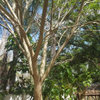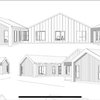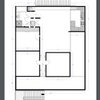A Future without Trees
Timandra Design & Landscaping
5 years ago
Why do so many people have an aversion with trees? Is it a lack of understanding of the absolute importance of trees in our environment? Or is it merely because of the presumed connotation of trees = mess?
I will say from the outset, that I am a fervent tree lover; of the variety who hugs trunks to feel the tree's driving energy. If you've never experienced this, it's worth doing. It is also an excellent way of determining the health and vigour of a tree, as a cool trunk denotes a healthy tree. If the sensation is dry and warm, then the tree is under stress, often due to a lack of water.
Trees are being felled at an alarming rate in both city and regional areas. It is the Australian indigenous trees that I am most concerned about. And they are being removed at an alarming rate. Our ubiquitous gum tree is really out of favour in many council areas.
Even in industrial areas, where too often trees succumb from the effects of industrial pollution, there are varieties of indigenous plants that will withstand most toxins. Sulphur is a particularly noxious pollutant that will kill trees.
Big trees are toppling with our worsening wind storms. We regularly see pictures during news broadcasts of big trees falling - often Eucalypts. Unfortunately this is giving these majestic beauties a bad name. And for the wrong reasons.
Urban sprawl has a lot to do with this problem. Arborists are called in as consultants to Civil Engineers to determine the viability of trees adjacent to proposed roads or road extensions. Either these arborists are unaware of the zone of influence of big trees, or the site construction manager is not following instruction.
Trees are too often falling because of human mismanagement, maybe years prior to the fall. It is not because it is a Eucalypt or big tree.
There is a formula for determining the protection zone around big trees. This is in dire need of further consideration. I believe it to be far too lenient against the well-being of the tree. And there appears to be no follow-up scrutiny by arborists after the construction phase is over; this should be made mandatory and signed off. This will add a cost to the overall project, but for the preservation of trees, is essential.
In heavy foot traffic areas why not make footpaths wider? Enough room for pedestrians, but an equal width, surrounded by aggregate, for trees to have the ability to grow without concrete around them. I have seen this done in some inner city areas, and thought how sensible this decision.
It's all about considering at all times, the well-being of the tree. They take many, many years to grow to their big size. They need to be preserved at all costs in optimum condition.
Trees can breathe through their root systems. If these roots are covered with asphalt, concrete or other non-porous material, then these trees will never perform well.
If trees were planted in clumps, using different varieties within the clump, this would yield greater health in this group with healthier ecosystems formed around biodiversity more so than monoculture. Planting in clumps also helps trees support each other during wind storms.
Tree corridors should be considered with urban planning. And these should, where possible, be locally indigenous plantings, to provide habitat for local birds and animals.
Councils need to develop strategies to combat complaints from residents who dont like trees. The environmental wellbeing of a region cant continue to be dictated by people who lack the capacity to recognize the increasing importance to human and environmental health from growing trees.
The 'dumbing down' factor has so much influence on so many things. Environmental integrity is one area where this effect should have no say at all. And it needs to be resoundingly rebutted if ignorant comment is made. Then maybe, trees will be able to live as respected health providers.
Alison Aplin
Timandra Design & Landscaping
www.timandra.com.au
I will say from the outset, that I am a fervent tree lover; of the variety who hugs trunks to feel the tree's driving energy. If you've never experienced this, it's worth doing. It is also an excellent way of determining the health and vigour of a tree, as a cool trunk denotes a healthy tree. If the sensation is dry and warm, then the tree is under stress, often due to a lack of water.
Trees are being felled at an alarming rate in both city and regional areas. It is the Australian indigenous trees that I am most concerned about. And they are being removed at an alarming rate. Our ubiquitous gum tree is really out of favour in many council areas.
Even in industrial areas, where too often trees succumb from the effects of industrial pollution, there are varieties of indigenous plants that will withstand most toxins. Sulphur is a particularly noxious pollutant that will kill trees.
Big trees are toppling with our worsening wind storms. We regularly see pictures during news broadcasts of big trees falling - often Eucalypts. Unfortunately this is giving these majestic beauties a bad name. And for the wrong reasons.
Urban sprawl has a lot to do with this problem. Arborists are called in as consultants to Civil Engineers to determine the viability of trees adjacent to proposed roads or road extensions. Either these arborists are unaware of the zone of influence of big trees, or the site construction manager is not following instruction.
Trees are too often falling because of human mismanagement, maybe years prior to the fall. It is not because it is a Eucalypt or big tree.
There is a formula for determining the protection zone around big trees. This is in dire need of further consideration. I believe it to be far too lenient against the well-being of the tree. And there appears to be no follow-up scrutiny by arborists after the construction phase is over; this should be made mandatory and signed off. This will add a cost to the overall project, but for the preservation of trees, is essential.
In heavy foot traffic areas why not make footpaths wider? Enough room for pedestrians, but an equal width, surrounded by aggregate, for trees to have the ability to grow without concrete around them. I have seen this done in some inner city areas, and thought how sensible this decision.
It's all about considering at all times, the well-being of the tree. They take many, many years to grow to their big size. They need to be preserved at all costs in optimum condition.
Trees can breathe through their root systems. If these roots are covered with asphalt, concrete or other non-porous material, then these trees will never perform well.
If trees were planted in clumps, using different varieties within the clump, this would yield greater health in this group with healthier ecosystems formed around biodiversity more so than monoculture. Planting in clumps also helps trees support each other during wind storms.
Tree corridors should be considered with urban planning. And these should, where possible, be locally indigenous plantings, to provide habitat for local birds and animals.
Councils need to develop strategies to combat complaints from residents who dont like trees. The environmental wellbeing of a region cant continue to be dictated by people who lack the capacity to recognize the increasing importance to human and environmental health from growing trees.
The 'dumbing down' factor has so much influence on so many things. Environmental integrity is one area where this effect should have no say at all. And it needs to be resoundingly rebutted if ignorant comment is made. Then maybe, trees will be able to live as respected health providers.
Alison Aplin
Timandra Design & Landscaping
www.timandra.com.au





Related Discussions
Room without a window
Q
Advice on trees and plants please
Q
Looking for a creative Christmas tree alternative
Q
Have 2 Trees and no idea where to plant them
Q